Dear Artist,
Back in the good old days, a select few youth were chosen to work in the studios of active and proven masters. After a few years of grinding pigments and other grunt work, they may or may not have had the opportunity to get their hands on a brush. In today’s world of instant gratification, most beginners prefer to cut to the chase without bothering with a proven master. While good quality workshops provide shortcuts for sure (see our Workshop Calendar) there are still many untutored and unguided, who wander daily into their studios to struggle on their own. With the current abundance of wonderful books by masters, this has also become an acceptable and often effective route.

Station Kanagawa, View of the Embankment (dai no kei, 臺之景/台之景); variant c; publisher seal Take (竹) (Hoeidō), circa 1833-35
Colour woodblock
by Utagawa Hiroshige (1797-1858)
Japan is a country where traditional apprentice-master approaches affect many areas of creativity. Known as Meisho-Deshi (May-ee-shoh-deh-she), some remarkable systems continue to frame and advance the Japanese miracle. Traditionally, apprentices were taken on at about age ten, and were not allowed to touch a master’s tools for several years. Surprisingly, some were not even allowed to ask questions. Even more surprisingly, they were taught to disdain the information provided by books. The apprentice was to learn by seeing and absorbing. The ideal apprentice was all eyes — and mute. If a master was very old when he passed on, the apprentice might be quite elderly, and quite quiet, before stepping into his sandals. Further, as well as “kata” — or “way of doing things,” learning to be a master involved philosophical and ethical obligations.
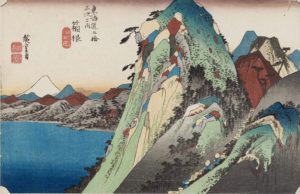
Station Hakone, View of the Lake, (kosui no zu, 湖水図); variant a; publisher seal Hoei (保永) and dō (堂), circa 1833-35
Colour woodblock
by Utagawa Hiroshige
Part of mastery lay in the need to develop an understanding of and sympathy for human nature. Further, with increased skills, prowess and consequent fame, obligations came automatically. A true master needed to live frugally and yet be generous with his earnings. Among the most ascetic masters, it was not good to keep a day’s earnings through the following night. We recognize that things have sped up since Utagawa Hiroshige (1797-1858) made woodblock prints of all those spots along the Tokaido Road. (These days the Shinkansen (bullet train) goes the length of it in about two hours.) But in our game, there is still a place for working, sharing, showing, and the good old business of demonstrating. Hiroshige, whose many apprentices developed in brilliant directions, would just be dazzled at the speed.
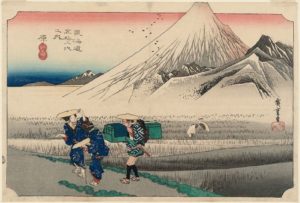
Station Hara, Mount Fuji in the Morning, (asa no Fuji, 朝之富士); variant a; publisher seal Takeuchi (竹内) (Hoeidō), circa 1833-35
Colour woodblock
by Utagawa Hiroshige
Best regards,
Robert
PS: “The Japanese system was geared to produce experts, not just men with enough training and experience to do adequate work. As a result, the quality standards for workmanship in all fields of labour were those requiring the ability and dedication of a master.” (Boye Lafayette De Mente, from “Elements of Japanese Design”)
Esoterica: It always surprises me when beginning artists do not make a rugged effort to search out their masters. Fear of “bothering” and shaky feelings of intimidation may be a couple of the reasons. Most masters I’ve known have been more than generous with their time and encouragement. Daily, I thank them for being there. I have, however, never known one who didn’t try to keep his earnings through the following night.
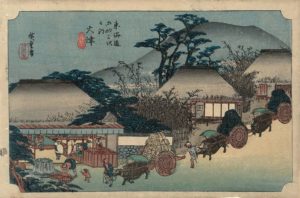
Station Ōtsu, Hashirii Teahouse (Hashirii chaya, 走井茶店; variant c; publisher seal Hoeidō (保永堂), circa 1833-35
Colour woodblock
by Utagawa Hiroshige
This letter was originally published as “Master-apprentice dynamics” on July 16, 2010.
Have you considered a Premium Artist Listing? With each letter, an artist is featured at the bottom of this page. The Premium Artist Listings are a means of connecting artist subscribers through their work. Proceeds from each listing contribute to the production of The Painter’s Keys.
“The temple bell stops but I still hear the sound coming out of the flowers.” (Matsuo Bashō)
Featured Workshop
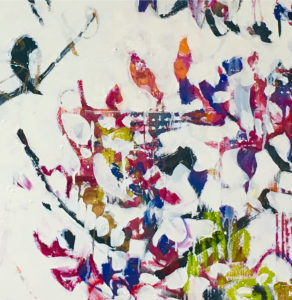 Join Ellie Harold for “Intuitive Painting: Permission to Paint Expressively,” designed especially for mature women artists of all skill levels who wish to explore this medium for soulful exploration. The retreat provides attractive accommodations (your own room!) along with lightly structured activities for centering, relaxation and low stress art-making. You’ll have plenty of free time to muse, paint, write and reflect while enjoying the colors, textures and flavors of San Miguel. This Retreat has the potential to transform not only your art but your life! You’ll return home with a specific art “care plan” to assure support for further creating. Details at www.EllieHarold.com.
Join Ellie Harold for “Intuitive Painting: Permission to Paint Expressively,” designed especially for mature women artists of all skill levels who wish to explore this medium for soulful exploration. The retreat provides attractive accommodations (your own room!) along with lightly structured activities for centering, relaxation and low stress art-making. You’ll have plenty of free time to muse, paint, write and reflect while enjoying the colors, textures and flavors of San Miguel. This Retreat has the potential to transform not only your art but your life! You’ll return home with a specific art “care plan” to assure support for further creating. Details at www.EllieHarold.com.

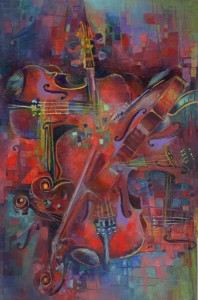



6 Comments
Even just gazing at masterful works is a start and to see a master in action is a gift. I am grateful to have had a number of opportunities to paint with master painters, like the Genn’s and finding them to be very generous.
We do not work in isolation even though our practice may be solitary.
beautiful pieces. I’ve sought out mentors. Sometimes they do not want to teach. I appreciate those more experienced who have encouraged and positively critiqued my work over the years. Trial and error still the operating system though.
I’ve had many mentors and I am now attempting to pay it back by becoming a mentor myself.
There are many artists who take on the role of mentor that are far from being in a masters category. Unfortunately, when we need the mentoring we don’t understand that fact. Looking back, I had good leadership and learning from good artists, and not so much. As we learn and understand what it is we are venturing to gain, eventually we get what that whole idea of mentoring is supposed to mean. Funny, I still after all these years find it all so contradicting. Be mentored by a master painter and make a habit of painting like him/her, but be sure to find your own way of painting. hmmmmmm
As a master wood turner, my late father was appalled that I gave away all my secrets by teaching and more recently by video. My reply to him was the one thing that the apprentice needs most is also the one thing I cannot give and that is experience.
All that I have learned and attemp to pass on cannot be appreciated to its fullest extent without putting in the mileage.